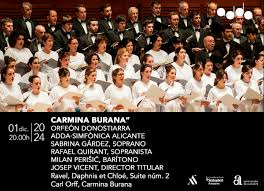How does one review a work in which one section is so well-known that it is perhaps better known as an aftershave advert on television than is a piece of music? How might one describe again an experience that has already been played through on multiple occasions? Here is the problem for this reviewer of last night’s concert in Aliante, in which the ADDA orchestra under Josep Vicent alongside Orfeón Donostiarra presented two utterly familiar masterpieces of twentieth century music. Let’s start with the aftershave
Given the opening paragraph, “old spice” is perhaps a good label from which to start. Carl Orff’s Carmina Burana is perhaps an example of old spice. Since it’s rapturous reception in Nazi Germany in 1937, it has continued to spice up concert programs in more ways than one. The composer chose to set these medieval poems, not only because they were interesting in themselves, but also because they were rather iconoclastic. Although written by clerics and monks several hundred years ago, they are at least tongue-in-cheek, anti-clerical, and anti-church. They are also bawdy and celebrate sex and drinking. Rabelaisian might be a relevant word.
But they do their iconoclastic work in the conventional format of a cantata with soloists, though only three of these, not four. One of them, usually sung by a tenor, has the utterly thankless task of playing a roasting swan with a skewer inserted in such a way that it changes the voice to falsetto. Though food seems to be the preoccupation, one is reminded of the medieval church’s propensity for making bonfires. The part was convincing sung by Rafael Quirant, who is a countertenor, who inspired genuine pathos amid the implied mirth.
Milan Perišić’s baritone was superb throughout. This is the meat of the soloists’ contribution, and his approach was genuinely and convincingly operatic. He generated superb dynamic contrasts at times and was thoroughly in control throughout. The soprano sung by Sabrina Gárdez, had two major contributions towards the end, and during the second, the voice has to live alone amongst those assembled vast forces. It has to modally meander its way through a solo without accompaniment, and then meander back again to finish in the right place. Many do not succeed, but Sabrina Gárdez did. During this sequence, one reflects how rarely in this work anyone sings anything without unison accompaniment.
And, speaking of singing, Orfeón Donostiarra visiting Aliante again did a wonderful job on the text. Their collective subtlety of expression brought out what was in the work to express. Much of this choral writing seems to have the character of plain chant with rhythm, so often there simply isn’t the opportunity to show off harmonic complexity. Rhythmically, it’s a very different story and our choir was perfect.
So what does one do musically with it? The quiet sections have to be quiet and lyrical, while the fireworks need to be loud, spectacular and perhaps augmented by both speed and volume. Josep Vicent chose to mix in both at the end of tutti phrases and everything worked beautifully.
The other part of the evening was devoted to another resident of the concert hall repertoire, the second suite of Daphne and Chloe by Ravel. There is nothing literal about this music. Everything is mere suggestion, an expression of whatever internal reality or myth Maurice Ravel was wont to experience. As ever with Ravel, it is hard to pin this music down. It has to be experienced live and its effect, though lasting, even permanent, does not prompt the retention of earworms. A wordless chorus does much more than add emphasis and volume to the beginning and end. In the dawn sequence, especially, they add harmonic texture and colour.
What is utterly
fascinating to see how the composer’s mind worked. In the opening dawn
sequence, the violins are playing a repeated, barely audible arpeggio, which
suggests darting insects, barely visible through the mist. This is music of
truly sophisticated complexity, containing sound that has to be experienced and
cannot be hummed, unlike Carl Orff’s masterpiece, which in comparison, does to
the audience what the skewer does to the swan.









